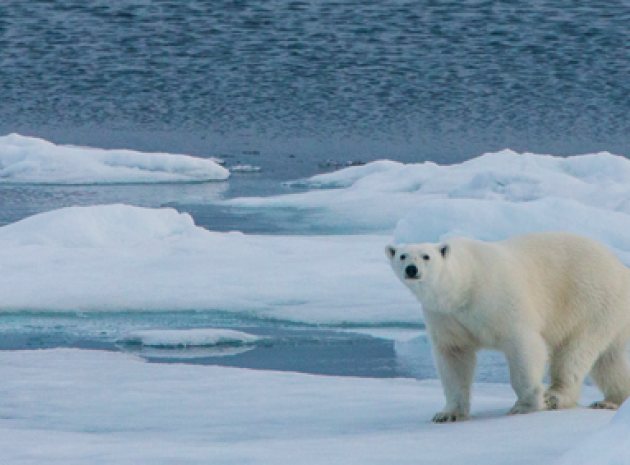Today you will…
Recognise the importance of having a view on the most important global issue of all time create an inventory of your knowledge about climate change.
Deep down you feel we are doomed. On a good day, though, there are signs we all ‘get it’ and will change our behaviour to save the world. How we feel and how we act are vital responses to thinking about geography. But sometimes issues are so complicated, what do we really know? This lesson is intended to get KS4 students thinking carefully about the subject of climate change, and how the way it is debated affects our understanding of the subject.
Starter activity
Show students this graph:

(source: tinyurl.com/8olr7ug) and share with them John Vidal’s article on Arctic sea ice levels (tinyurl.com/cwe5euu), that was published in the Guardian on August 21st, 2012.
Q: Describe the average for the period 1979-2000. What has happened in 2012?
This paragraph adds to the evidence in the graph: “Ice volume in the Arctic has declined dramatically over the past decade. The 2011 minimum was more than 50% below that of 2005. According to the Polar Science Centre at the University of Washington it now stands at around 5,770 cubic kilometres, compared with 12,433 cu km during the 2000s and 6,494 cu km in 2011. The ice volume for 31 July 2012 was roughly 10% below the value for the same day in 2011. A new study by UK scientists suggests that 900 cu km of summer sea ice has disappeared from the Arctic ocean over the past year.”
Consider these observations of the situation:
“The consequences of losing the Arctic’s ice coverage for the summer months are expected to be immense. If the white sea ice no longer reflects sunlight back into space, the region can be expected to heat up even more than at present. This could lead to an increase in ocean temperatures with unknown effects on weather systems in northern latitudes. In a statement, a Greenpeace spokesman said: ‘The disappearing Arctic still serves as a stark warning to us all. Data shows us that the frozen north is teetering on the brink. The level of ice ‘has remained far below average’ and appears to be getting thinner, leaving it more vulnerable to future melting. The consequences of further rapid ice loss at the top of the world are of profound importance to the whole planet. This is not a warning we can afford to ignore.’”
Main activities

1. Time-scale
The data in the starter activity looks at a sensitive five-month period and compares it to a twenty-year average for that period. It is alarming specific evidence and combines with the 1000 year records which reveal the over-arching measure and impact of climate change. It might be hoped that prior to Year 10 and 11 pupils will have come across the ‘hockey stick’ graph as it probably represents the most profound visualisation of climate change.
To explore if this image is indeed in pupils’ prior learning ask them to draw the line of global temperature change over 1000 years before they are presented with a completed version (tinyurl.com/9uupam7). Checking the title, scales and data sources should be an essential first task for any graph. Essentially, the line shows fairly steady temperatures for almost a thousand years until the last part of the 20th century and then suddenly shooting upwards. The horizontal shaft of the ice-hockey stick turns for the steep angle of the blade.
This New Scientist article (tinyurl.com/9uupam7) refers to the 2001 report from the Intergovernmental Panel on Climate Change (IPPC) version. It compares this with other reconstructions to bust the myth that the hockey stick graph is wrong. The back-story to why it suits some people to call it a myth is complicated but it was subsequently revealed that communications between the scientists in this field were not harmonious. That is insufficient reason to say the representation of temperature change is wrong.
Pupils may be aware of where the hockey stick graph appears in textbooks and other sources.
2. Climate change and poverty
The evidence for climate change is dramatic in extreme environments, yet it is also having a severe impact on global development in many other parts of the world. The poorest people are least resilient to the changes in their environment.
Draw a table to show the inter-connected impacts of climate change and global issues. It is not necessary for each pupil to complete every grid-square, but for them to show understanding of the issues in a geographical context. Select some images to accompany the text:
Agriculture and food security Water insecurity Rising sea-levels Eco-system and biodiversity Migrations Health and well-being
Make further references to other locations studied. Perhaps this information could be mounted around a world map on the wall. It is an opportunity for pupils to demonstrate synoptic understanding in geography. Ensure there is a balance of environmental, social, economic and political information. They could have a section headed: Questions we haven’t answered yet.
3. The real debate
In geographical terms climate change is a global and local reality. There is only interconnectedness. The real question is of a political nature: what can or must we do about it? This pervades our consideration of consumption, use of resources, transport and quality of life. It raises justice and equity. It concerns actions now and for the future. One approach would be to consider the likely and desirable future scenarios. Specifying a wish-list for future generations can encourage a more optimistic outlook. Seeing ways to close the gap between what is actually happening and what should be possible is a positive interpretation. Ask pupils to develop an inventory of what else they need to know. It is already clear that a quick fix is not around the corner. They can use these questions:
• How can I enjoy a good quality of life, without transferring problems to people in other parts of the world?
• How can I become an active global citizen and help look after the planet for future generations?
Home learning
Activity 1 hints at opposing views generating heat out of scientists’ evidence and uncertainties. Sustainable development is said to meet the needs of the present, without compromising the ability of future generations to meet their own needs. One way to help pupils through their own thinking is to use sustainability concepts such as: interdependence; citizenship & stewardship; needs & rights of future generations; diversity; quality of life; sustainable change; uncertainty & precaution. Ask students to write an explanation of any two of these terms in relation to climate change.
Summary
Having a geographical view on climate change is important. Neutrality is bogus: we can’t stand everywhere and we can’t stand no-where. But a particular view needs to be backed up with considered evidence and, as geographers, it should be located. Pupils need to know what they don’t know. Even when climate change appears over-bearing, learners can consider their actions and think positively about being global citizens.
Info Bar
Additional resources
Climate Change: A Guide for the Perplexed – tinyurl.com/93aal6a
Looking to the Future, Geographical Association Annual Conference 2013 – tinyurl.com/8cegtca
Morgan, Alun (2008) Think Piece – Global Warming, Geographical Association – tinyurl.com/93x532f
Stretch them further
Further exploration of the attempts to de-bunk climate change will show they tend not to use specific geographical examples. taking care not to be swept up by powerful interests, pupils could test some of these myths.
About the expert
Angus Willson is a geographer, educator, and consultant based in Ashford, Kent. Working with government departments, companies and voluntary-sector organisations, he has a keen focus on professional engagement for curriculum-making and leadership. pannage.com









